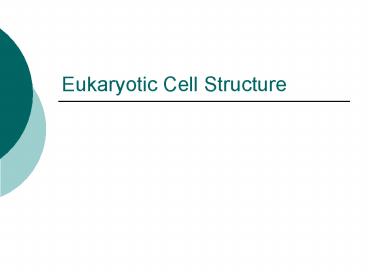Eukaryotic Cell Structure - PowerPoint PPT Presentation
1 / 19
Title:
Eukaryotic Cell Structure
Description:
Eukaryotic Cell Structure Essential Questions What are the functions of the major cell structures? Organelles Little organs Specialized structures of the cell ... – PowerPoint PPT presentation
Number of Views:185
Avg rating:3.0/5.0
Title: Eukaryotic Cell Structure
1
Eukaryotic Cell Structure
2
Essential Questions
- What are the functions of the major cell
structures?
3
Organelles
- Little organs
- Specialized structures of the cell
- Each organelle has unique functions
- These organelles allow the cell to function
properly
4
Organelle Groups
- Cell biologists divide organelles into three
groups based on their location - Nucleus nucleolus, chromatin, nuclear envelope
- Cytoplasm mitochondria, vacuole, Golgi
apparatus, centrioles, lysosomes, ribosomes,
chloroplasts, endoplasmic reticulum (ER) - Surface cell membrane, cell wall
5
Group 1 - Nucleus
- 1. Nucleus
- Control center of the cell
- Contains nearly all cell DNA
- 2. Nuclear Envelope
- Surrounds the nucleus
- Contains nuclear pores, which allow material to
move into and out of the nucleus
6
Nucleus cont
- 3. Chromatin
- Consists of DNA bound to a protein
- Condenses to form chromosomes
- 4. Nucleolus
- Small, dense region
- Assembly of ribosomes begin here
7
Group 2 - Cytoplasm
- The portion of the cell outside the nucleus
- Contains many organelles
- Gel-like substance that protects the organelles
- Allows movement
8
Cytoplasmic organelles
- 1. Ribosome
- Small particles of RNA and protein found
throughout the cytoplasm - Responsible for the assembly of proteins
- Follows coded instructions from the nucleus
- Numerous in cells active in protein synthesis
9
- 2. Endoplasmic Reticulum (ER)
- Site where lipid components, proteins and other
materials are exported from the cell - Rough ER
- Involved in the synthesis of proteins
- Ribosomes are found on its surface
- Smooth ER
- Contains collections of enzymes
- Synthesis of membrane lipids
- Detoxification of drugs
10
- 3. Golgi Apparatus (aka Golgi Bodies)
- Proteins in the rough ER move next into the Golgi
Apparatus - It modifies, sorts, and packages proteins for
storage or secretion - Ships proteins to their final destination
11
- 4. Lysosomes
- Small organelles filled with enzymes
- clean up crew
- Digestion, or breakdown, of lipids,
carbohydrates, and proteins so the rest of the
cell can use them - Removes dead organelles
12
- 5. Vacuoles
- Saclike structures that store materials
- Plant cells the vacuole is a single, large
central organelle filled with liquid - Allows for support of leaves and flowers
- Help maintain homeostasis
- Also found in some animal cells
13
- 6. Mitochondria
- Power house of the cell
- Responsible for the cell energy
- Converts stored energy in food into compounds
that the cells can use - Contains its own DNA
- Some scientists believe that mitochondria, at one
point, may have been a prokaryotic cell
14
- 7. Chloroplasts
- Only found in plant cells
- Capture energy from sunlight and convert it into
chemical energy (called photosynthesis) - Contains chlorophyll (Gives plants its color)
- Contains its own DNA
- Some scientists believe that mitochondria, at one
point, may have been a prokaryotic cell
15
- 8. Centrioles
- Come from structures called microtubules
- Located near the nucleus
- Help to organize cell division
- Only in Animal Cells
16
Group 3 - Surface
- Cytoskeleton (cell skeleton)
- A network of protein filaments that help the cell
maintain its shape - Also aids in movement (Flagellum and Cilia)
17
- 1. Cell membrane
- Cell membrane regulates what enters and leaves
the cell - Provides protection and support
- 2. Cell wall
- Main function is to provide support and
protection - Only in plant cells
18
(No Transcript)
19
(No Transcript)































